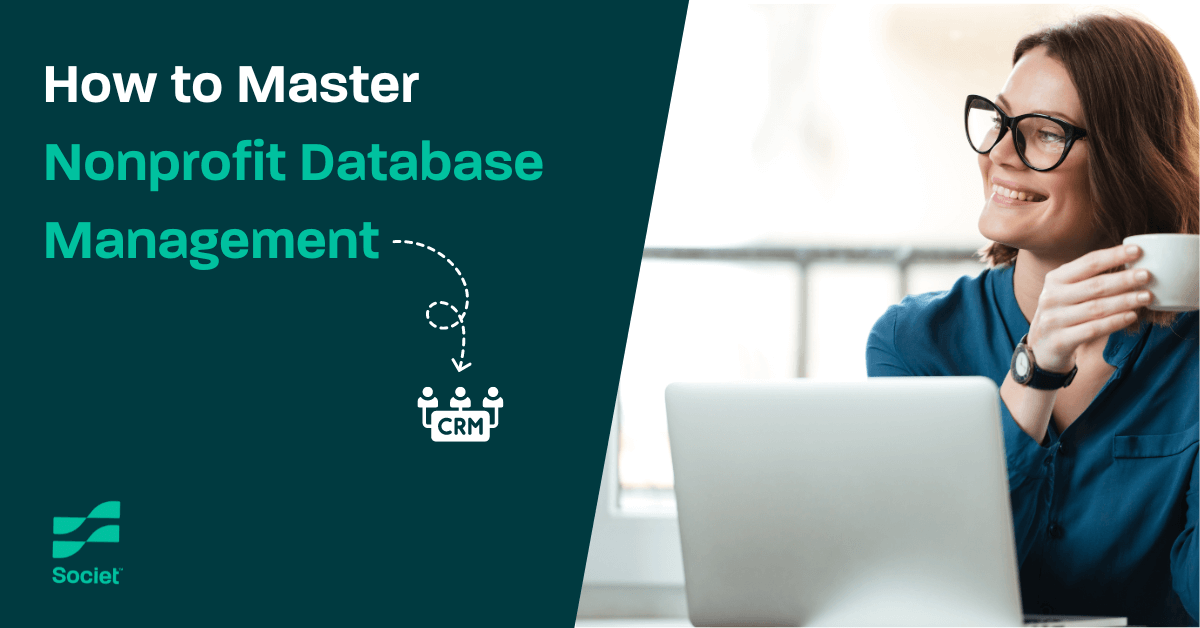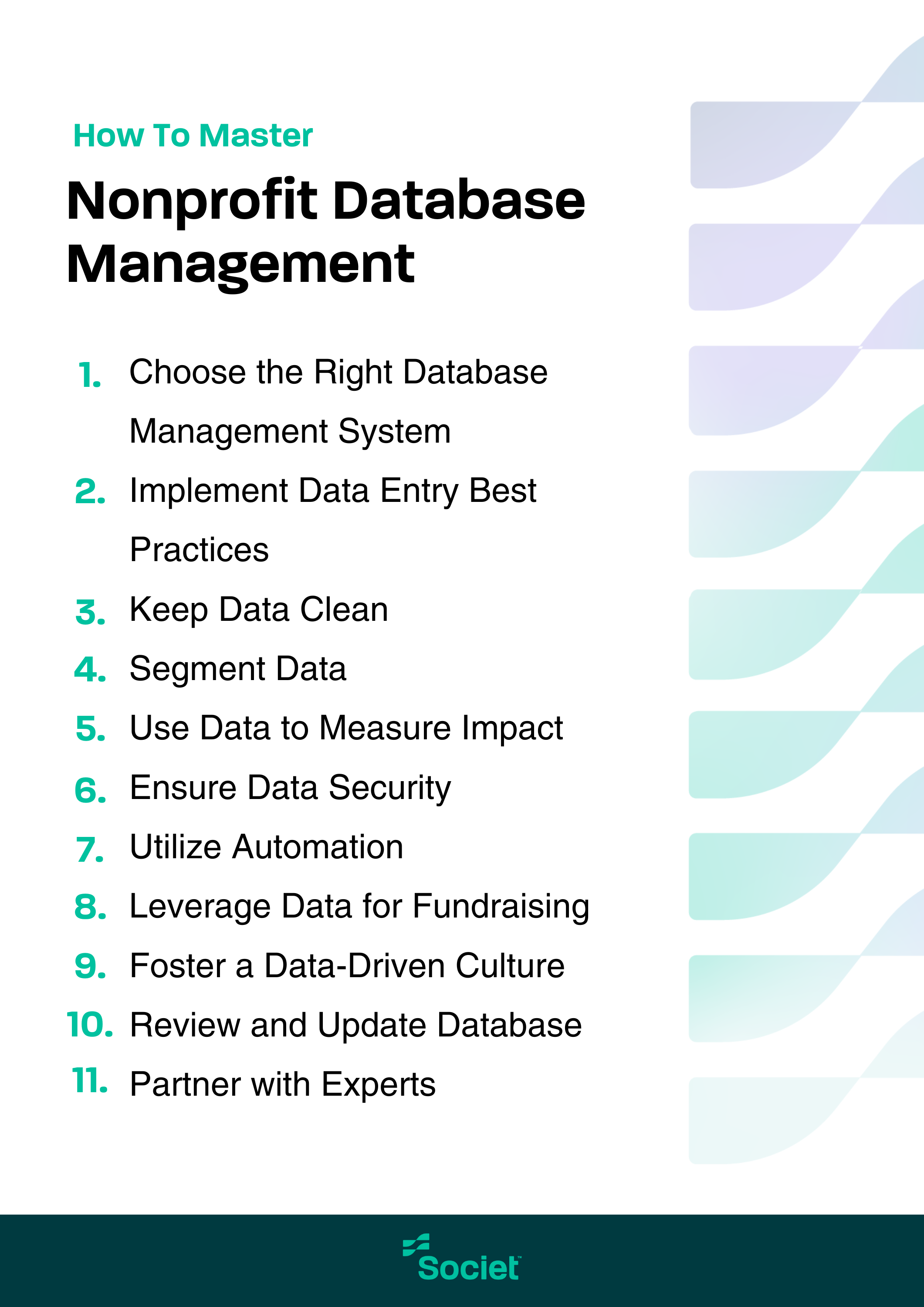
In the nonprofit world, data is the backbone of every successful operation. Whether you’re tracking donor contributions, managing volunteer activities, or measuring the impact of your programs, effective nonprofit database management is essential.
This guide will help you master nonprofit database management, ensuring your organization can thrive and make a lasting impact.
Why Nonprofit Database Management Matters
Peter Drucker famously said, “What gets measured gets managed.” In the nonprofit sector, this translates to understanding your data to drive your mission forward. Effective database management can help you:
- Track Donations: Keep a detailed record of all donations, ensuring you can acknowledge and thank donors appropriately.
- Manage Volunteers: Coordinate volunteer activities and track their contributions.
- Measure Impact: Collect and analyze data to measure the effectiveness of your programs.
- Improve Communication: Segment your audience for targeted communication, increasing engagement and support.
#1. Choose the Right Database Management System
The first step in excelling at nonprofit database management is selecting the right system. Your database should be tailored to meet the unique needs of your organization. Consider factors such as the size of your organization, the complexity of your data, and your budget.
Sumac CRM: A Comprehensive Solution
One excellent option is Sumac Nonprofit CRM. Sumac is designed specifically for nonprofits, offering features such as donor management, volunteer tracking, and event management. With Sumac CRM, you can centralize all your data in one place, making it easier to manage and analyze.
#2. Implement Data Entry Best Practices
Once you have chosen your database management system, the next step is to implement best practices for data entry. Accurate and consistent data entry is crucial for maintaining the integrity of your database.
Tips for Accurate Data Entry
- Standardize Data Formats: Ensure that all data is entered in a consistent format. For example, use the same date format (MM/DD/YYYY) and standardize address formats.
- Train Your Team: Provide training to all staff and volunteers who will be entering data. This ensures everyone understands the importance of accurate data entry and follows the same procedures.
- Regular Audits: Conduct regular audits of your database to identify and correct any errors or inconsistencies.
#3. Keep Your Data Clean
It’s common to have data stored in different places and in different formats—on the web, in a spreadsheet, in a donor database, etc.
Sometimes, the information is outdated. The more recent and accurate your data, the more useful a BI tool can make it. And remember: Only use data that is meaningful and useful to you. If you don’t know what to do with the data, don’t use it.
Steps to Maintain a Clean Database
- Merge Duplicate Records: When cleaning your database, find duplicates and combine the information to gain better donor reporting. Online donation processors like Donorbox make it easy to merge duplicate donor files.
- Keep Donor Records Updated: Your donors have real lives, and that means they will move, marry, and divorce. This information is essential when tracking and communicating with donors.
- Create Best Practices to Follow: Create policies for data entry that include adding the same basic info for your donors, including names, addresses, titles, phone numbers, email, and more.
#4. Segment Your Data for Targeted Communication
One of the most powerful features of a well-managed database is the ability to segment your data. Segmentation allows you to tailor your communication to different groups within your audience, increasing the effectiveness of your outreach efforts.
How to Segment Your Data
- Donor Segmentation: Segment donors based on factors such as donation amount, frequency, and recency. This allows you to tailor your appeals and acknowledgments to different donor groups.
- Volunteer Segmentation: Segment volunteers based on their skills, availability, and past contributions. This helps you match volunteers with the right opportunities.
- Program Segmentation: Segment program participants based on demographics, participation history, and outcomes. This allows you to tailor your programs to meet the needs of different groups.

#5. Use Data to Measure Impact
Data is a powerful tool for measuring the impact of your programs. By collecting and analyzing data, you can demonstrate the effectiveness of your programs to donors, stakeholders, and the community.
Steps to Measure Impact
- Define Metrics: Identify the key metrics you will use to measure the impact of your programs. These could include outcomes such as the number of people served, improvements in quality of life, or changes in behavior.
- Collect Data: Use your database to collect data on these metrics. This could include surveys, interviews, and program records.
- Analyze Data: Analyze the data to identify trends and measure the impact of your programs. Use this information to make data-driven decisions and improve your programs.
#6. Ensure Data Security
Data security is a critical aspect of nonprofit database management. Protecting the personal information of your donors, volunteers, and program participants is not only a legal requirement but also essential for maintaining trust.
Best Practices for Data Security
- Access Controls: Implement access controls to ensure that only authorized personnel can access sensitive data.
- Encryption: Use encryption to protect data both in transit and at rest.
- Regular Backups: Regularly back up your data to prevent loss in case of a system failure or cyberattack.
- Compliance: Ensure your database management practices comply with relevant data protection regulations, such as GDPR or CCPA.
#7. Utilize Automation for Efficiency
Automation can significantly improve the efficiency of your nonprofit database management. By automating routine tasks, you can free up time for your staff to focus on more strategic activities.
Examples of Automation
- Donation Processing: Automate the processing of online donations, including sending acknowledgment emails and updating donor records.
- Volunteer Coordination: Use automation to schedule volunteer shifts, send reminders, and track hours.
- Reporting: Automate the generation of reports, such as monthly donation summaries or program impact reports.
#8. Leverage Data for Fundraising
Data is a valuable asset for fundraising. By analyzing your donor data, you can identify trends, predict future giving, and tailor your fundraising strategies to maximize results.
Fundraising Strategies Using Data
- Donor Retention: Use data to identify lapsed donors and implement targeted strategies to re-engage them.
- Major Gifts: Analyze donor data to identify potential major gift prospects and tailor your cultivation strategies accordingly.
- Campaign Analysis: Use data to analyze the effectiveness of your fundraising campaigns and make data-driven decisions for future campaigns.
#9. Foster a Data-Driven Culture
To excel at nonprofit database management, it’s essential to foster a data-driven culture within your organization. This means encouraging staff and volunteers to use data to inform their decisions and continuously improve their work.
Steps to Foster a Data-Driven Culture
- Training: Provide ongoing training on data management and analysis to all staff and volunteers.
- Data Sharing: Encourage the sharing of data and insights across departments to promote collaboration and continuous improvement.
- Recognition: Recognize and reward staff and volunteers who use data effectively to achieve your organization’s goals.
#10. Regularly Review and Update Your Database
Maintaining an up-to-date database is crucial for effective nonprofit database management. Regularly reviewing and updating your database ensures that your data remains accurate and relevant.
Tips for Regular Database Maintenance
- Data Cleaning: Regularly clean your database to remove duplicate records, correct errors, and update outdated information.
- Data Enrichment: Enrich your data by adding new information, such as updated contact details or additional donor preferences.
- System Updates: Keep your database management system up to date with the latest software updates and security patches.
#11. Partner with Experts
If managing your nonprofit’s database seems overwhelming, consider partnering with experts. A nonprofit marketing agency like Frontier Marketing can provide valuable support, from setting up your database to implementing advanced data analysis techniques.
Benefits of Partnering with Experts
- Expertise: Benefit from the expertise of professionals who specialize in nonprofit database management.
- Efficiency: Save time and resources by outsourcing complex tasks to experts.
- Advanced Techniques: Access advanced data analysis techniques and tools that may not be available in-house.
Conclusion
Effective nonprofit database management is essential for driving your mission forward. By choosing the right database management system, implementing best practices for data entry, and avoiding common errors, you can excel at nonprofit database management and make a lasting impact.
Remember, as W. Edwards Deming said, “In God we trust; all others must bring data.” Embrace the power of data to transform your nonprofit and achieve your mission.


